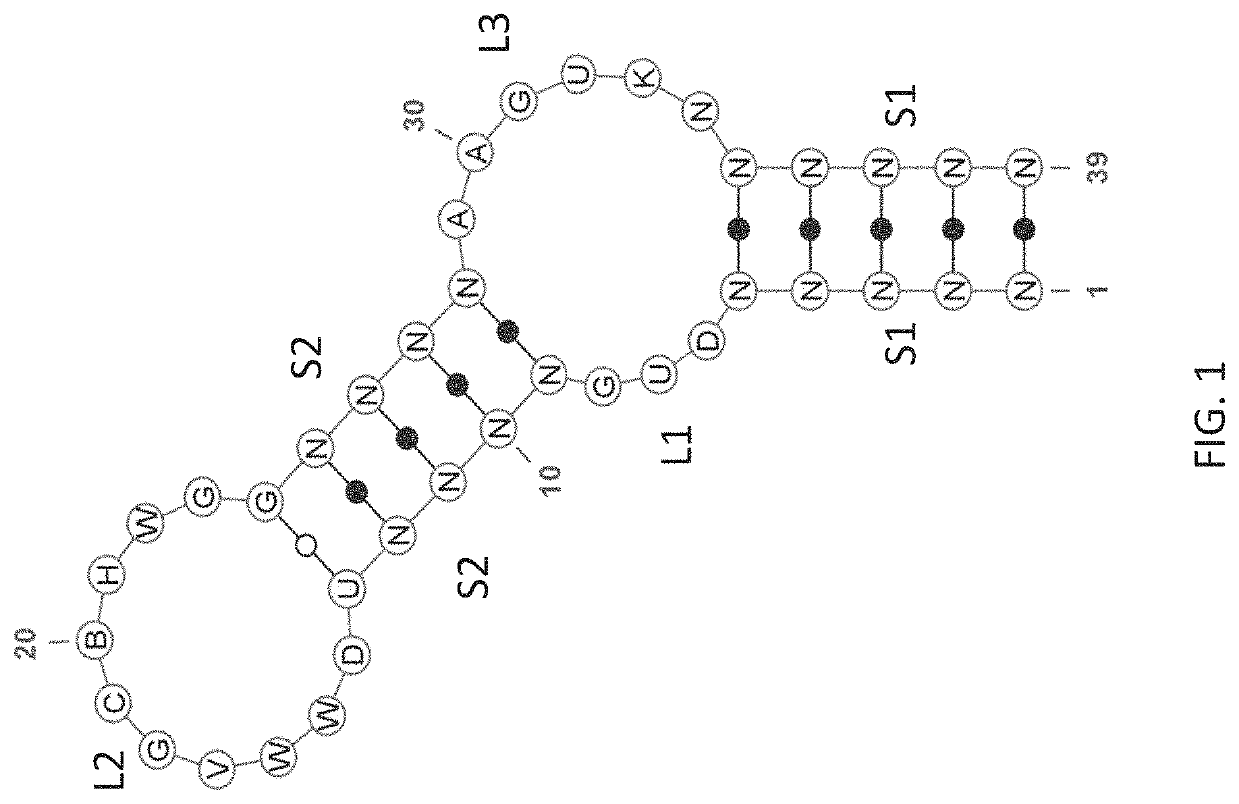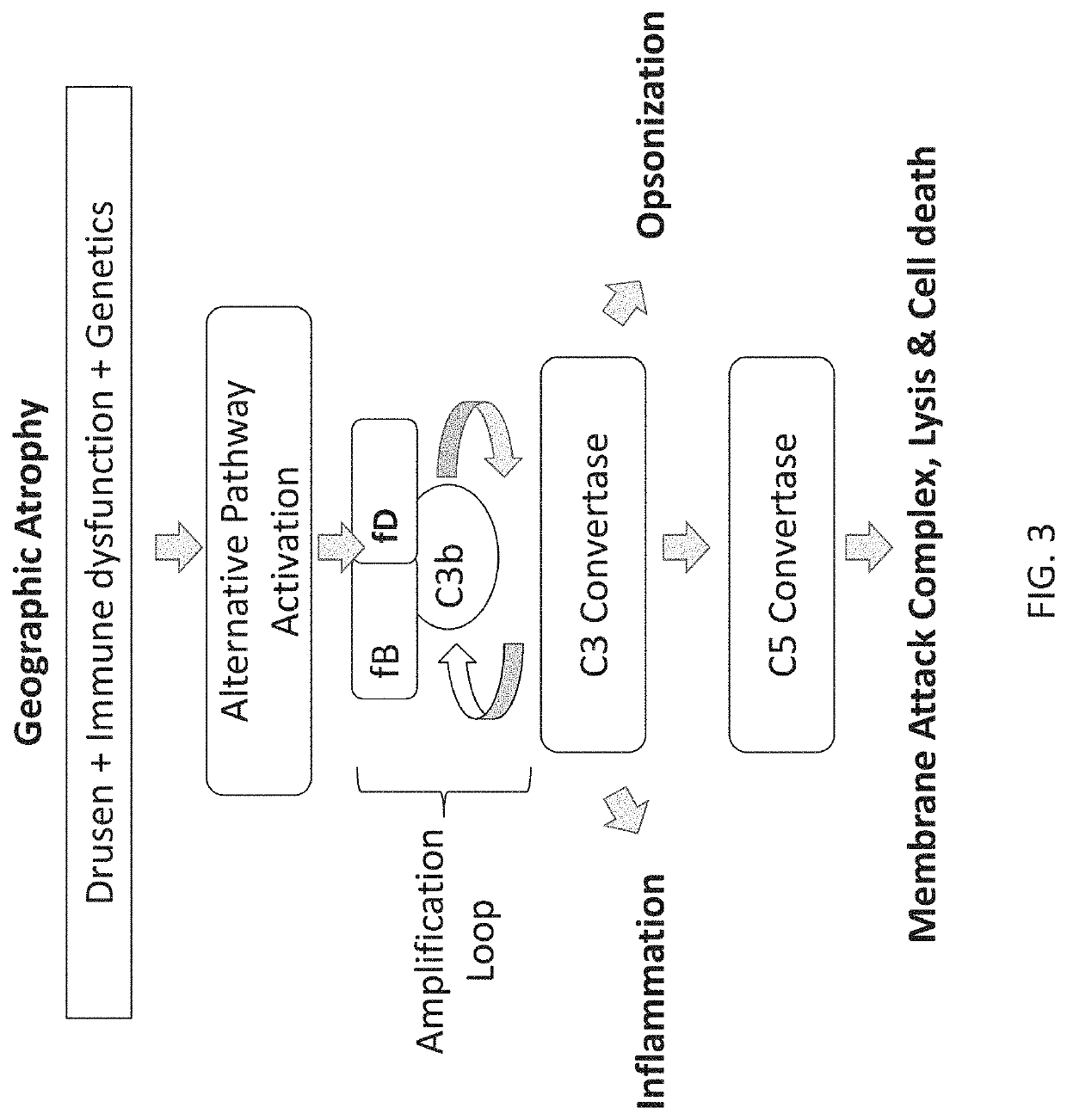Stem-loop compositions and methods for inhibiting factor D
a technology of stem loops and compositions, applied in the direction of dna/rna fragmentation, organic active ingredients, biochemistry apparatuses and processes, etc., can solve the problems of dry amd or geographic atrophy, cell death and retinal atrophy, and no fda-approved treatment exists
- Summary
- Abstract
- Description
- Claims
- Application Information
AI Technical Summary
Benefits of technology
Problems solved by technology
Method used
Image
Examples
example 1
ation of Modified RNA Aptamers to fD
A. Selection of Anti-Factor D Aptamers
[0258]Anti-factor D (fD) aptamers were identified using an N30 library (N30S) comprised of a 30-nucleotide random region flanked by constant regions containing a built-in stem region as depicted in FIG. 7A. The sequence in italics represents the forward and reverse primer binding sites. The built-in stem region is underlined. FIG. 7B depicts a representation of the N30S library with the reverse oligo hybridized. For nuclease stability, the library was composed of 2′-fluoro-G (2′F GTP) and 2′-O-methyl (2′OMe) A / C / U. FIG. 7C depicts structures of modified nucleotides used to generate the N30S library for selection against target fD. For simplicity, the nucleosides, and not the nucleotide triphosphates are shown.
[0259]The library sequence (underlined sequences represent the built-in stem) and the sequence of oligos used to amplify the library are described in Table 4.
[0260]
TABLE 4Library sequence and sequence of ...
example 2
ation of fD Inhibitors in Hemolysis Assays
[0276]In some cases, the disclosure provides for the identification of aptamers that inhibit a function associated with fD. In some cases, the identification of aptamers that that inhibit a function associated with fD may involve performing an alternative complement-dependent hemolysis assay. Human serum that is rendered deficient in the classical complement pathway by depleting Clq may be dependent on alternative complement activity to lyse rabbit red blood cells, an activity that may be dependent on fD. (Katschke, Wu, Ganesan, et al. (2012) Inhibiting alternative pathway complement activation by targeting the Factor D exosite. J. Biol. Chem. 287, 12886-12892).
[0277]Briefly, citrated rabbit blood was centrifuged at 500×g for 5 minutes at room temperature. The top plasma fraction was removed and the volume was replaced with 1× Veronal buffer containing 0.1% gelatin (prepared from 5× Veronal buffer, Lonza #12-624E and 2% gelatin solution, Sig...
example 3
[0282]In some cases, a fD esterase activity assay may be used to test the activity of putative anti-fD aptamers. In some cases, inhibition of esterase activity may suggest that the anti-fD aptamer is binding to the catalytic cleft, the associated substrate binding specificity pockets, or sterically occluding access to the active site. In some cases, an enhancement of esterase activity may suggest that the anti-fD aptamer is binding to the exosite in a manner which causes allosteric activation, such as observed for an anti-fD Fab having an amino acid sequence of heavy chain variable region according to SEQ ID NO:7 and a light chain variable region according to SEQ ID NO:8. In yet other cases, no effect on esterase activity in combination with inhibition of hemolysis may suggest that the anti-fD aptamer is binding the exosite in manner that does not cause allosteric activation, or is binding to neither the exosite or catalytic cleft. Cleavage of a modified pepti...
PUM
| Property | Measurement | Unit |
|---|---|---|
| stem-loop secondary structure | aaaaa | aaaaa |
Abstract
Description
Claims
Application Information
 Login to View More
Login to View More - R&D
- Intellectual Property
- Life Sciences
- Materials
- Tech Scout
- Unparalleled Data Quality
- Higher Quality Content
- 60% Fewer Hallucinations
Browse by: Latest US Patents, China's latest patents, Technical Efficacy Thesaurus, Application Domain, Technology Topic, Popular Technical Reports.
© 2025 PatSnap. All rights reserved.Legal|Privacy policy|Modern Slavery Act Transparency Statement|Sitemap|About US| Contact US: help@patsnap.com



